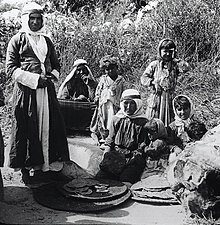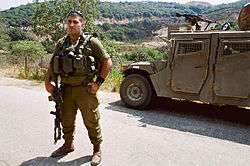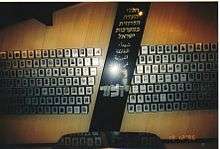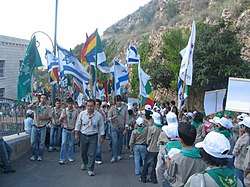Druze in Israel
The Israeli Druze (Arabic: الدروز الإسرائيليون, Hebrew: דְּרוּזִים יִשְׂרְאֵלִים) are a religious and ethnic minority among Arab citizens of Israel.[2] In 2019, there were 143,000 Druze living in Israel, 1.6% of the total population of the country.[1] Even though the faith originally developed out of Ismaili Islam, Druze do not identify as Muslims.[3][4][5][6] In 1957, the Israeli government designated the Druze a distinct ethnic community at the request of its communal leaders. The Druze are Arabic-speaking citizens of Israel who serve in the Israel Defense Forces. Members of the community have attained top positions in Israeli politics and public service.[7] Before the establishment of the State of Israel, the Druze were not recognized as a religious community, and were discriminated against by the judicial system.[8] They live mainly in the north of the country.[9] A 2017 Pew Research Center poll reported that the majority of the Israeli Druze identified as ethnically Arab.[10]
| Total population | |
|---|---|
| 143,000, 1.6% of Israeli population (2019)[1] | |
| Regions with significant populations | |
| Languages | |
| |
| Religion | |
| Druze |
| Part of a series on
Druze |
|---|
 |
|
Beliefs
|
|
Important figures |
|
Texts
|
|
Holy places |
|
Holy days |
|
Related topics
|
|
History
The Druze (Arabic: درزي, Derzī or Durzī, plural دروز, Durūz; Hebrew: דְּרוּזִים, Druzim; they call themselves al-Muwaḥḥidīn, lit., "the Monotheists") are an esoteric, monotheistic religious community found primarily in Syria, Lebanon, Israel, and Jordan. The religion incorporates elements of Isma'ilism, Gnosticism, Neoplatonism, and other philosophies. The Druze call themselves Ahl al-Tawhid - "People of Unitarianism or Monotheism" - or al-Muwaḥḥidūn, "Unitarians, Monotheists". Amin Tarif was the preeminent religious leader of the community until his death in 1993.[11]
Relations with the Jews on the eve of the 1948 Arab–Israeli War
During the 1947–48 Civil War in Mandatory Palestine, the Druze in Mandatory Palestine were under pressure from both the Jewish Yishuv leadership and from the Palestinian Arab Higher Committee, and found it difficult to form an opinion about the conflict between the Jews and the Palestinian Arabs. Noble Druze men from nearby countries visited Druze villages in Palestine and preached neutrality. During the early days of the conflict, a meeting of all the noblemen from all the Druze villages was conducted in Daliyat al-Karmel, where they all agreed not to take part in the riots instigated by the Arab Higher Committee. This decision was backed by Druze leaders in Jabal al-Druze. In the Druze community, there were opposing trends: In mixed Druze and Muslim villages such as Isfiya, Shefa-'Amr, and Maghar, where there were old sectarian disputes, and in Druze villages near Haifa and the Jewish settlement in the western Galilee, the local Druze leaders tended to prefer the Jews in the conflict; at the Druze villages deep in Arab areas, the local leaders were more careful with support of the Jews. Josh Palmon was tasked by the Jewish Agency for Israel to manage the relationship with the Druze. He initially led a preventive approach with the Druze, aimed at making sure the Druze will not join the Arab Higher Committee.[12]

The contacts between the Druze and the Jewish leadership were made through Labib Hussein Abu Rokan from Isfya and Salah-Hassan Hanifes from Shefa-'Amr (both became members of the Knesset after Israel's establishment). Hanifas managed to bring the Druze village Yarka to co-operate with the Jews.[12]
Arrival of Druze volunteers from nearby countries during the war
During the war, Druze volunteers arrived to Mandatory Palestine in order to help defend the Druze villages there. When the Arab Liberation Army (ALA) was created by the Arab League, Shakib Wahhab, a Syrian–Druze military commander resigned from the Syrian army and established a Druze battalion for the ALA, collecting Druze volunteers who joined mostly due to economic reasons from Syria and Lebanon. Wahhab brought around 500 men and arrived to Shefa-'Amr in Palestine, where he established his command on 30 March 1948. The commander of the ALA, Fawzi al-Qawuqji, planned to deploy the Druze battalion in the northern regions of Samaria under his command, but the military committee of the Arab League decided to establish a separate command for the Druze for the region near the city of Haifa, excluding Acre. Wahhab traveled through the western Galilee region and sent men to the Druze villages of the Carmel. As the Druze volunteers arrived, there were attempts to talk with the volunteers, due to fear local Druze will join them. Najib Mansour, the head of Isfiya, met with agents of the Hagannah in Haifa to discuss the arrival of Wahhab. Mansour did not agree to the demand that the local Druze would forcibly oppose the volunteers, and instead proposed the Jews bribe Wahhab to abandon his command.[13]
Military service and public office
Druze citizens are prominent in the Israel Defense Forces and in politics. The bond between Jewish and Druze soldiers is commonly known by the term "a covenant of blood" (Hebrew: ברית דמים, brit damim).[14]
Five Druze lawmakers were elected to serve in the 18th Knesset, a disproportionately large number considering their population.[15] Reda Mansour, a Druze poet, historian, and diplomat, explained: "We are the only non-Jewish minority that is drafted into the military, and we have an even higher percentage in the combat units and as officers than the Jewish members themselves. So we are considered a very nationalistic, patriotic community."[16]
Druze Zionism


In 1973, Amal Nasser el-Din founded the Zionist Druze Circle,[17][18] a group whose aim was to encourage the Druze to support the state of Israel fully and unreservedly.[19] Today, thousands of Israeli Druze belong to Druze Zionist movements.[20]
In 2007, Nabiah A-Din, mayor of Kisra-Sumei, rejected the "multi-cultural" Israeli constitution proposed by the Israeli Arab organization Adalah: "The state of Israel is a Jewish state as well as a democratic state that espouses equality and elections. We invalidate and reject everything that the Adalah organization is requesting", he said. According to A-din, the fate of the Druze and the Circassians in Israel is intertwined with that of the state. "This is a blood pact, and a pact of the living. We are unwilling to support a substantial alteration to the nature of this state, to which we tied our destinies prior to its establishment", he said.[21] As of 2005 there were 7,000 registered members in the Druze Zionist movement.[20] In 2009, the movement held a Druze Zionist youth conference with 1,700 participants.[22]
In a survey conducted in 2008 by Dr. Yusuf Hassan of Tel Aviv University found that out of 764 Druze participants, more than 94% identify as "Druze-Israelis" in the religious and national context.[23][24]
On 30 June 2011, Haaretz reported that a growing number of Israeli Druze were joining elite units of the military, leaving the official Druze battalion, Herev, under-staffed. This trend has led to calls for its disbandment.
On May 15, 2015, it was announced that the Druze battalion Herev would be shut down, thereby allowing Druze soldiers to integrate into the rest of the IDF, a wish that was relayed to IDF senior staff by leaders in the Druze community as well as former Herev battalion commanders. After the July 2015 Draft, the IDF no longer listed the Druze unit as an option. By September 2015, the battalion had been disbanded, and its soldiers joined to other units.[25]
Druze also serve in elite units of the IDF such as the Sayeret Matkal, and there are three Druze combat pilots serving in the Israeli Air Force.[26]
Religion

The Druze religion branched off from the religion of Islam, and is now considered its own religion separate from Islam. The religion was created in the 10th and 11th centuries in Egypt, with aspects of Hindu and Greek philosophy incorporated into the tenets of Islam. Conversions are not permitted in the Druze religion, because they believe that the first generation after the establishment of the Druze religion had an opportunity then to join the religion, and everyone alive today is reincarnated from that generation. Much like the Abrahamic faiths, the Druze religion is monotheistic, and recognizes many prophets, including Jesus,[27][28] John the Baptist,[27][28] Mohammed, Khidr and Moses. Their most respected prophet in their religion is Jethro, Moses' father-in-law.[29]
The Epistles of Wisdom is the foundational text of the Druze faith.[30] The Druze faith incorporates elements of Islam's Ismailism,[31] Gnosticism, Neoplatonism,[32][33] Pythagoreanism,[34][35] Christianity,[36][37][38] Hinduism[39][35] and other philosophies and beliefs, creating a distinct and secretive theology known to interpret esoterically religious scriptures, and to highlight the role of the mind and truthfulness.[35]
Within the Druze community, there are two different sub-groups. There is the al-Juhhal, or the Ignorant, and al-Uqqal, the Knowledgeable. The al-Juhhal group does not have the permission to view the holy texts, and they do not attend religious meetings. About 80% of the Druze people fall into this category of the Ignorant. The al-Uqqal must follow ascetic rulings including following a dress code. The most powerful 5% of the Knowledgeable group are where the spiritual leaders of the religion come from. As for important rules that the Druze must follow, they are not allowed to drink alcohol, eat pork, or smoke tobacco, similarly to the dietary laws in Islam. Polygamy is prohibited, and men and women are viewed as equals. Many of the Druze living in Israel fully participate in Israeli society, and many of them serve in the Israeli Defense Forces.[29]
The Druze revere the father-in-law of Moses, Jethro or Reuel, a Kenite shepherd and priest of Midian.[40] In Exodus, Moses' father-in-law is initially referred to as "Reuel" (Exodus 2:18) but then as "Jethro" (Exodus 3:1). According to the biblical narrative, Jethro joined and assisted the Israelites in the desert during the Exodus, accepted monotheism, but ultimately rejoined his own people. The tomb of Jethro near Tiberias is the most important religious site for the Druze community and they gather there every April.[41]
Amin Tarif was the qadi, or spiritual leader, of the Druze in Palestine and Israel from 1928 until his death in 1993. He was highly esteemed and regarded by many within the community as the preeminent spiritual authority in the Druze world.[42]
In January 2004, the current spiritual leader, Sheikh Muwaffak Tarīf, called on all non-Jews in Israel to observe the Seven Noahide Laws, as laid down in the Bible and expounded upon in Jewish tradition. The mayor of the Galilean city of Shefa-'Amr also signed the document.[41] The declaration includes the commitment to make a "... better humane world based on the Seven Noahide Commandments and the values they represent commanded by the Creator to all mankind through Moses on Mount Sinai".[41]
Settlements
The Druze in Israel live in a handful of sectarian villages and several mixed-religion Arab localities in pre-1967 Israel (Upper and Lower Galilee and Mount Carmel) and on the Golan Heights. The population figures are as follows (absolute figures and percentage of overall population):[1]
| Northern District
(not including Golan Subdistrict) |
Haifa District | Golan Subdistrict[43]
(sub-section of Northern District) |
|---|---|---|
|
|
|
Status and position of Golan Heights Druze
There are four remaining Druze villages in the Israeli-annexed portion of the Golan Heights—Majdal Shams, Mas'ade, Buq'ata, and Ein Qiniyye—in which 23,000 Druze live.[44][45][46] Most of the Druze residents of the Golan Heights consider themselves to be Syrians and refuse to take Israeli citizenship, instead holding Israeli permanent resident status, and in place of an Israeli passport use an Israeli-issued laissez-passer document for travelling abroad, on which the citizenship paragraph is left empty.[47]
Since the adoption of the 1981 Golan Heights Law, the territory has been under Israeli civil law, and incorporated into the Israeli system of local councils.[48] After the annexation of the Golan Heights in 1981, the Israeli government offered citizenship to all non-Israelis living in the territory,[47][49] but (as of 2011), less than 10% of the local Druze accepted it.[50] In 2012, however, due to the Syrian Civil War, dozens of young Druze have applied for Israeli citizenship - a much larger number than in previous years.[51] By 2017, nearly 5,500 out of 26,500 residents had applied for and received an Israeli passport since 1981. The yearly number of applications steadily rose, with 183 applying in 2016, compared to only five in 2000.[52]
During the 2011 Syrian uprising, Druze in the Golan Heights held several rallies in support of Syrian leader Bashar al-Assad.[53] Public support for the Assad government has historically been high among Golan Druze, and Syria has secured agreements with the Israeli government to permit Golan Druze to conduct trade across the border with Syria. Some tensions have recently arisen in the community due to differing stances on the Syrian Civil War, though open public support for the Syrian opposition has been relatively uncommon.[54]
In the 2009 elections, 1,193 residents of the Alawite village of Ghajar and 809 residents of the Druze villages were eligible to vote, out of approximately 1,200 Ghajar residents and 12,600 Druze village residents who were of voting age.[55] As Israel does not recognize the Syrian citizenship of Golan Druze, they are defined in Israeli records as "residents of the Golan Heights". Those who apply for Israeli citizenship are entitled to vote in Israeli elections, run for Knesset, and receive an Israeli passport. Residents of Majdal Shams are not drafted into the Israel Defense Forces.[7]
See also
- List of Israeli Druze
- IDF Sword Battalion
- Religion in Israel
- Ahuzat Naftali
References
- "The Druze population in Israel - a collection of data on the occasion of the Prophet Shuaib holiday" (PDF). CBS - Israel. Israel Central Bureau of Statistics. 17 April 2019. Retrieved 8 May 2019.
- http://www.pewresearch.org/fact-tank/2016/03/21/5-facts-about-israeli-druze-a-unique-religious-and-ethnic-group/
- "Are the Druze People Arabs or Muslims? Deciphering Who They Are". Arab America. Arab America. 8 August 2018. Retrieved 13 April 2020.
- Léo-Paul Dana (1 January 2010). Entrepreneurship and Religion. Edward Elgar Publishing. p. 314. ISBN 978-1-84980-632-9.
- James Lewis (2002). The Encyclopedia of Cults, Sects, and New Religions. Prometheus Books. Retrieved 13 May 2015.
- De McLaurin, Ronald (1979). The Political Role of Minority Groups in the Middle East. Michigan University Press. p. 114. ISBN 9780030525964.
Theologically, one would have to conclude that the Druze are not Muslims. They do not accept the five pillars of Islam. In place of these principles the Druze have instituted the seven precepts noted above..
- Religious Freedoms: Druze. Theisraelproject.org. Retrieved on 2012-01-23. Archived 14 September 2012 at Archive.today
- Aharon Layish (1982). Marriage, Divorce, and Succession in the Druze Family: A Study Based on Decisions of Druze Arbitrators and Religious Courts in Israel and the Golan Heights. Leiden, The Netherlands: E. J. Brill. p. 12. ISBN 90-04-06412-5. Retrieved 14 October 2014.
- Dr. Naim Aridi. "The Druze in Israel: History & Overview". Jewish Virtual Library. Retrieved 23 January 2012.
- "Israel's Religiously Divided Society". Pew Research Center. 8 March 2016. Retrieved 8 December 2017.
- Pace, Eric (5 October 1993). "Sheik Amin Tarif, Arab Druse Leader In Israel, Dies at 95". The New York Times. Retrieved 29 March 2010.
- Yoav Gelber, Independence Versus Nakba; Kinneret–Zmora-Bitan–Dvir Publishing, 2004, ISBN 965-517-190-6, p. 115
- Yoav Gelber 2004, p. 116
- Firro, Kais (15 August 2006). "Druze Herev Battalion Fights 32 Days With No Casualties". Arutz Sheva.
- Stern, Yoav (3 August 2011). "Elections 2009 / Druze likely to comprise 5% of next Knesset, despite small population". Haaretz. Retrieved 23 January 2012.
- Christensen, John (15 November 2008). "Consul General is an Arab Who Represents Israel Well". Atlanta Journal-Constitution. Archived from the original on 29 June 2011. Retrieved 27 June 2010.
- Kais Firro (1999). The Druzes in the Jewish state: a brief history. Social, Economic and Political Studies of the Middle East. Brill Academic Pub. p. 210. ISBN 978-9004112513.
- Mordechai Nisan (2002). Minorities in the Middle East: a history of struggle and self-expression (2nd ed.). McFarland & Company. p. 109. ISBN 978-0786413751.
- Jacob M. Landau (1993). The Arab minority in Israel, 1967–1991: political aspects. Oxford University Press. p. 46. ISBN 978-0198277125.
- Eli Ashkenazi (3 November 2005). הרצל והתקווה בחגיגות 30 לתנועה הדרוזית הציונית [Herzl and hope in celebrating 30 (years of the) Druze Zionist movement]. Haaretz (in Hebrew). Retrieved 14 October 2014.
- Stern, Yoav (1 March 2007). "Druze, Circassian forum: Israel should remain a Jewish state". Haaretz. Retrieved 22 June 2010.
- Samar Odeh (9 December 2009). הציונות הדרוזית היא אהבת מדינת ישראל והתרומה למדינת ישראל ['Druze Zionism is the love of the state of Israel and contribution to the state of Israel'] (in Hebrew). Radio Haifa. Archived from the original on 21 July 2011.
- Shtern, Yoav (4 March 2008). "רה"מ לדרוזים: לא עוד ברית דמים, אלא ברית חיים [PM to Druze: No more blood pact, but life pact]". Walla!. Archived from the original on 28 August 2016. Retrieved 26 June 2016.
- "Study: 94% of Druze in Israel define themselves as Druze-Israeli". Ynet. 4 March 2008. Retrieved 26 June 2016.
- Yaakov Lappin (15 May 2015). "To promote integration, IDF shuts down Druse battalion". Jerusalem Post. Retrieved 18 May 2015.
- [56 years of Druze soldiers serving in the IDF] Rotem Pesso, 03/05/2012
- Hitti, Philip K. (1928). The Origins of the Druze People and Religion: With Extracts from Their Sacred Writings. Library of Alexandria. p. 37. ISBN 9781465546623.
- Dana, Nissim (2008). The Druze in the Middle East: Their Faith, Leadership, Identity and Status. Michigan University press. p. 17. ISBN 9781903900369.
- "Druze Religion". International Fellowship of Christians and Jews. http://www.ifcj.org/learn/inside-israel/people-society/religions-of-israel/druze-religion.html.
- Nejla M. Abu Izzeddin (1993). The Druzes: a new study of their history, faith, and society. BRILL. pp. 108–. ISBN 978-90-04-09705-6. Archived from the original on 7 July 2014. Retrieved 17 March 2011.
- Daftary, Farhad (2 December 2013). A History of Shi'i Islam. I.B.Tauris. ISBN 978-0-85773-524-9.
- Quilliam, Neil (1999). Syria and the New World Order. Michigan University press. p. 42. ISBN 9780863722493.
- The New Encyclopaedia Britannica. Encyclopaedia Britannica. 1992. p. 237. ISBN 9780852295533.
Druze religious beliefs developed out of Isma'ill teachings. Various Jewish, Christian, Gnostic, Neoplatonic, and Iranian elements, however, are combined under a doctrine of strict monotheism.
- Rosenthal, Donna (2003). The Israelis: Ordinary People in an Extraordinary Land. Simon and Schuster. p. 296. ISBN 978-0-684-86972-8.
- Kapur, Kamlesh (2010). History of Ancient India. Sterling Publishers Pvt. Ltd. ISBN 978-81-207-4910-8.
- Quilliam, Neil (1999). Syria and the New World Order. Michigan University press. p. 42. ISBN 9780863722493.
- Quilliam, Neil (1999). Syria and the New World Order. Michigan University press. p. 42. ISBN 9780863722493.
- The New Encyclopaedia Britannica. Encyclopaedia Britannica. 1992. p. 237. ISBN 9780852295533.
Druze religious beliefs developed out of Isma'ill teachings. Various Jewish, Christian, Gnostic, Neoplatonic, and Iranian elements, however, are combined under a doctrine of strict monotheism.
- The Israelis: Ordinary People in an Extraordinary Land Archived 20 March 2017 at the Wayback Machine, Donna Rosenthal, Simon and Schuster, 2003, p. 296
- Harris, Stephen L., Understanding the Bible. Palo Alto: Mayfield. 1985.
- "Islam Religious Leader Commits to Noahide "Seven Laws of Noah"". Institute of Noahide Code. Archived from the original on 8 August 2007. Retrieved 2007-07-15.
- Dana, Nissim (2003). The Druze in the Middle East: Their Faith, Leadership, Identity and Status. Sussex Academic Press. p. 14. ISBN 978-1903900369.
- Should be updated to a link to "Golan Subdistrict" article once that article is created and written in English
- "LOCALITIES(1) AND POPULATION, BY POPULATION GROUP, DISTRICT, SUB-DISTRICT AND NATURAL REGION" (PDF). CBS Israeli Central Bureau of Statistics. 31 December 2017.
- Melhem, Ahmad (11 April 2019). "Trump paves way for Israel to expand settlements in Golan". Al-Monitor. Retrieved 9 May 2019.
- Kershner, Isabel (23 April 2019). "Netanyahu Seeks to Name a Golan Heights Settlement for President Trump". The New York Times. ISSN 0362-4331. Retrieved 9 May 2019.
- Mort, Jo-Ann (13 July 2012). "Daydream Believers: A Saturday in Majdal Shams on the Golan Heights". New York: Dissent Magazine. Retrieved 21 January 2017.
...still consider themselves citizens of Syria today... Since the Israelis annexed the Golan in 1981, the Syrian Druze have been eligible for Israeli citizenship, but most reject it and instead have permanent resident status and a , with their citizenship line empty, except for a line of stars.
- Golan Heights Law, MFA.
- Scott Wilson (30 October 2006). "Golan Heights Land, Lifestyle Lure Settlers". The Washington Post. Retrieved 5 June 2007.
- Isabel Kershner (22 May 2011). "In the Golan Heights, Anxious Eyes Look East". The New York Times. Retrieved 23 January 2012.
- Ilan Ben Zion (5 October 2012). "With Syria ablaze, dozens of Golan Heights Druze seek Israeli citizenship". The Times of Israel. Retrieved 14 October 2014.
- https://www.haaretz.com/israel-news/an-israeli-ethnic-minority-swears-allegiance-to-syria-but-that-s-changing-1.5453460
- Luis Ramirez (2 May 2011). "Israeli Druze Keep An Eye Across Fence as Syria Upheaval Unfolds". Voice of America. Retrieved 2 May 2011.
- Stratford, Charles (28 September 2012). "Golan's Druze divided over Syria unrest". Majdal Shams: Al Jazeera English. Retrieved 28 November 2012.
- "Results of the elections for the 18th Knesset" (csv) (in Hebrew). Central Elections Committee. (eligible voters in column D). For age structure, see CBS.gov.il publications. For population, see CBS.gov.il Ishuvim Archived 21 November 2010 at the Wayback Machine
Further reading
- Mordechai Nisan (Autumn 2010). "The Druze in Israel: Questions of Identity, Citizenship, and Patriotism". The Middle East Journal. 64 (4): 575–596. doi:10.3751/64.4.14.